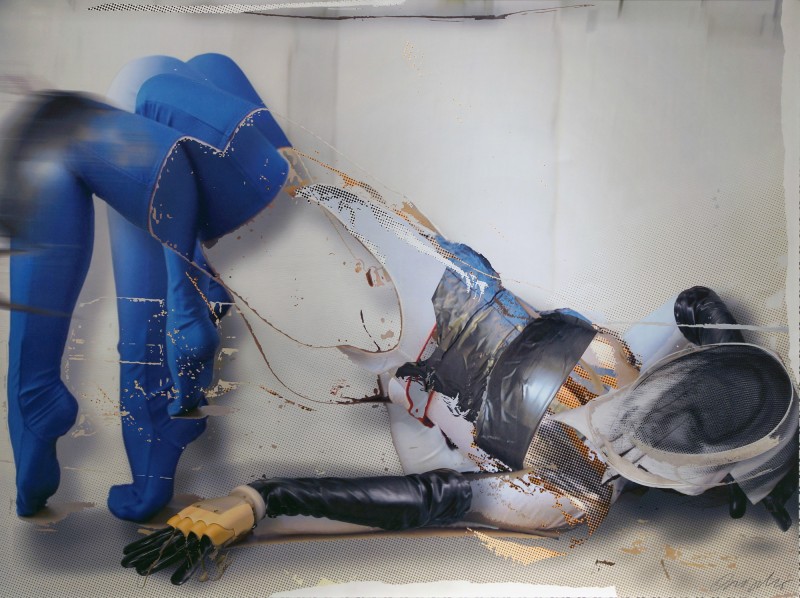
acrylic on paper
38.5 x 50.5 in.
Deborah Oropallo continues her exploration of the iconography of power and costume in a new series of mixed-media works depicting abstracted female forms clad in superhero costumes. Oropallo’s inspiration for these prints was a troupe of female performers in Los Angeles, whose thriving web-based business venture involves dressing up in superhero costumes and enacting live-action comic books. The artist’s digital manipulation of these figures and their outfits zeroes in on ambiguous moments of dressing and undressing, where a metamorphosis, a kind of becoming or un-becoming, seems to be taking place. This ambiguity is heightened by the artist’s removal of nearly any trace of human flesh or faces from each figure, a signature move that destabilizes the work, creating a tension between figuration and abstraction: because so much information has been removed from each image, the fragments and gestures that remain assume both an air of mystery and a critical significance.
In a 2009 essay on Oropallo’s work, Nick Stone writes: “We know that we are decoding these images not because we are sure of what they mean but precisely because we are unsure; from a semiotic point of view, the works’ indeterminacy is what makes them tick. Because the code is not immediately legible, we become aware of its presence, and are confronted by a system which we may not have even been aware that we were using. This tendency to mask and unmask via layers and distortion is a consistent theme for Oropallo: in a 2004 interview she noted, ‘I’m always trying to soften the definition, [to] dissolve the images a little more.’ Beginning with the Feign series and continuing through the works collected here, Oropallo’s work has increasingly honed in on this theme; she has committed herself to a singular exploration of this indeterminacy, the process of blurring, distorting, and erasing information so as to scramble the viewer’s radar. In Feign, the digitally painted figures are recognizable as such, and their gender roles and costumes are fairly clear; it is the surface code, the medium, the code of line and color on a ground, which is being interrupted and jammed. As the figures in Guise become more indistinct and the boundaries of each figure and his or her costume – the boundaries of his or her very his-ness or her-ness – suddenly the codes of gender and power begin to break down and dissolve into one another. And in Wild Wild West, the figures have disappeared completely, as if acid has eaten away at the underlying medium by which these codes are transmitted. In this series it is as if Oropallo is paring each image down in search of the barest minimum of information necessary for our eyes to read into line and shape a link to some conceptual referent. By feeding our internal codecs ever fuzzier and more ambiguous data, she dares us to be sure of the meaning we take from each image.”
show prices
Prices and availability are subject to change without notice.The copyright of all art images belongs to the individual artists and Magnolia Editions, Inc.
©2003-2025 Magnolia Editions, Inc. All rights reserved. contact us
